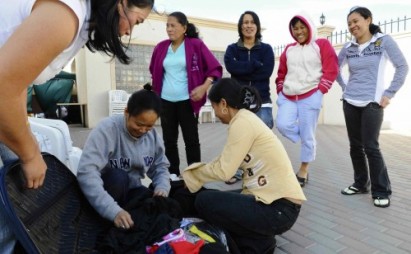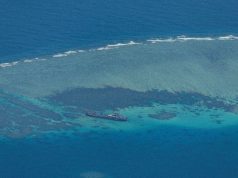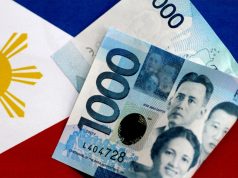Editor’s note: Cesar Polvorosa Jr. is a business school professor of economics, world geography, and international business in Canada and a published writer in economics, business, and literature. Some sections are revised excerpts from his chapter in the book “Filipinos in Canada” published by the University of Toronto Press (2012). This is the first of three installments. Expect the second part on Sunday, November 23.
“Let the Filipino guy sing! They are the best,” clamored my Japanese friends as they handed me the microphone. It was the moment I dreaded when attending parties especially in Japan, the land of karaoke. Forced to oblige, in under a minute I successfully destroyed their stereotyped image of all Filipinos as the minstrels of the modern era. It was my first taste of Filipinos stereotyped as entertainers when I was a graduate student in Japan decades ago.
Indeed, when I was introduced to other Japanese the response was often, “so are you singer or dancer?” or something similar. And no, I am not also a good dancer as my wife will vigorously attest to with laughter.
Filipinos outside the homeland dispersed to the far-flung corners of the earth are well over 11 million strong. This massive migration is primarily due to lack of opportunities in the homeland facilitated by the historic ties with Western colonizers and adaptability to other cultures, useful skills, English language proficiency, and the ease of travel in the era of globalization. Subsequently, Filipinos abroad have a significant presence in many occupations as construction workers, engineers, bank managers, educators, accountants, cooks, fast-food workers, architects, maintenance services staff, doctors, nurses, IT professionals, technicians, seafarers, caregivers, domestic helpers, entertainers, etc.
When my son was malling for the first time at the Scarborough Town Center in the suburbs of Toronto he exclaimed, “Papa, Filipinos are everywhere!” Indeed, Filipinos are pervasive in specific North American urban spaces and also in places such as the World Wide House in Hong Kong or Lucky Plaza at Orchard Road in Singapore and a visible 10 percent of the UAE population.
The Pinoy dispersal
Vibrant Filipino communities carve out their niches in diverse places — the frigid tundra of the far North, the burning desert sands of the Middle East, the lush forests of Africa and the verdant tropical islands of the Pacific. Filipinos are in cosmopolitan cities from Tokyo to Toronto, Dubai to Dublin, LA to Lagos, Melbourne to Milan and London, Ontario to London, England. According to the Commission on Overseas Filipinos the top five countries with the biggest number of Filipinos as of December 2012 include: United States of America (3.5 million), Saudi Arabia (1.3 million), United Arab Emirates (931,562), Canada (852,401), Malaysia (686,547), and Australia (391,705). Filipinos are found in 218 countries and often in great numbers that the term “diaspora” is used to describe the Filipino global community just as for the more numerous Chinese and Indians.
The concept of diaspora has transcended its origin in the history of Jewish dispersal. The modern diaspora pertains to the large-scale and long-term movements of people across boundaries. Filipino-American academic Epifanio San Juan Jr. amplified that diasporic groups are characterized by a historical connection to a homeland, a desire for eventual return and a collective identity centered on homeland myths and memories. San Juan asserts that the Filipino diaspora is distinct with its connection to particular regions and communities of languages and traditions, rather than the nation itself, due to the long period of colonization.
More than remittances
With such huge overseas communities the Philippines stands out as one of the biggest recipients of remittances. World Bank 2013 data show that India is the world leader in remittance flows, receiving $70 billion, China is second at $59.5 billion, and the Philippines, recently overtaking Mexico, now ranks third with $26.7 billion – and though less than half of China’s it’s quite remarkable since the Philippine population is less than 10 percent of behemoths China or India.
Thus, Philippine remittances comprise about 10 percent of the country’s GDP, far exceeding the 4 percent for India. Remittances of overseas Filipino workers (OFWs) provide an economic lifeline to numerous Philippine families feeding a consumer boom that supports local industries and also builds up foreign exchange reserves that shore up the country’s Balance of Payments position.
Transcending the economic aspects, overseas Filipinos have also enriched Philippine society through achievements in the arts, literature, sciences, and education. The diaspora permeates the national life in its discourses and narratives through numerous everyday cases — the aged parents in the Philippines receiving money from children in the Mideast and caring for the grandchildren left behind, yet another despedida or farewell party for kin leaving for abroad, stories of immigrant achievers but also of OFWs suffering abuses by employers, etc.
Friends and relatives visit the Philippines bringing pasalubong or gifts. Grand reunions of clans have relatives coming from all over the world. Indeed, on school alumni sites on Facebook the scope and depth of the diaspora is evident. It’s likely that one-fourth or one-third of my fellow alumni is now abroad with enough members in California alone to have regular reunions there.
Precursor of OFWs
Wanderlust is in the DNA of the Filipino. As an archipelagic people, the ancestors of Filipinos were renowned as adventurous navigators. The country’s status as a Spanish colony ruled for centuries through Mexico meant that from the 16th century onwards Filipinos have journeyed to the Americas via the Manila galleons as sailors. A group of Filipino patriots led by Jose Rizal congregated in Spain during the twilight of the empire.
As the Philippines became a US possession, Filipinos worked in Alaskan canneries, the pineapple, and sugar cane plantations of Hawaii, and as agricultural laborers in California – the precursor of the modern-day OFWs.
Philippine migration to other countries skyrocketed during the last half century as economic boom and rapidly aging societies led to labor shortages in Canada, Western Europe, and Japan. Prosperity encouraged as well their citizens to shirk from low-paying jobs. Meanwhile, North America, Australia and New Zealand beckoned immigrants.
The oil bonanza from the late 1970s fueled massive infrastructure and building projects in the Middle East and boosted demand for construction workers and engineering personnel, especially from the Philippines and South Asia.
At the same time, amidst rapid progress in many countries, the Philippines was mired in crisis and poverty during the past generation.
This confluence of “push” and “pull” factors considerably expanded Filipino immigration and the diaspora. Philippine underdevelopment and immigration are thus inextricably intertwined.
Convent- and Hollywood-raised
Nick Joaquin had been quoted as saying that “The Philippines spent 300 years in a convent and 50 years in Hollywood.” It creatively encapsulated the clash and contradictions in the Filipino psyche between the religiosity of Spain and the explicitly materialist aspirations of the USA overlaid on the foundation of the indigenous Malay culture sprinkled with Chinese and Indian influences.
The clannishness of the East and the individuality of the West likewise mingled and became embedded in the nation’s soul. It may be argued that the incongruous mixture of diverse regional cultures and colonial experiences engendered the Filipino’s retarded development of national identity which in turn, stifled national cohesion and progress.
The Philippines has often been referred to as the Latin American country located in the Far East. For James Fallows it was the “damaged culture” thesis and just this year, the geographer Robert Kaplan made a similar harsh commentary in his chapter on the Philippines in “Asia’s Cauldron,” where he strangely described Manila as “somnolent and purposeless.”
A fragmented geography with formidable physical barriers was pivotal in the arrested development of national unity and identity of Filipinos. The seeds of nationalism planted in the 1880s had been crushed by the Americans in the early 1900s. The Filipino nation is very much a work in progress as a young nation imbued with both youthful vitality and an inchoate identity.
Unifying Filipino vision?
The aborted nascent nationalism impacts through the country’s uncertainty about its dreams and directions and its role in the global stage. Thus, is there a unifying, eloquently articulated, and deeply appreciated Filipino vision?
Filipino communities abroad are the microcosm of the divisive regionalism of Filipino society – the number of Philippine region-based community associations stands out and with dispersed resources, there is often an inability to undertake grand projects.
Ultimately, the confluence of geographic and historical circumstance becomes a prescription for the persistence of underdevelopment. In Southeast Asia, it is the archipelagic countries of Philippines and Indonesia similarly colonized by Europeans that were laggards in national unity and development.
The nation is past the time acknowledging these stumbling blocks in its past. The imperative is now to resolve them, move on and trust that the early struggles will eventually mold the nation to mature and become an achieving and progressive society.
One critical lesson of history is that there is no unique path to development. The Anglo-Saxon Protestant work ethic in North West Europe had been followed by the Confucian Crescent model of development of East Asia as the cultural explanation for sustained and superior economic outcomes.
It requires a leap of faith at the present but in the long run, these apparent contradictions in the Filipino character will catalyze into an invaluable asset. The Filipino nation offers a unique synthesis of the East and West that becomes an advantage in the process of immigration.










